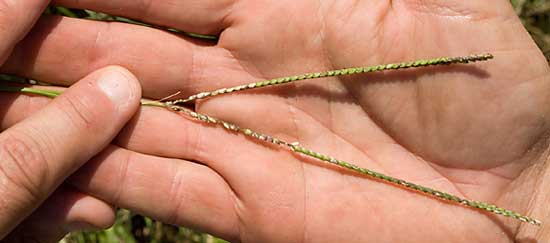Washington, DC
April 1, 2008By
Sharon
Durham
A new bahiagrass may provide
forage growers with a better shot at beating back weeds before
they gain a stranglehold on forage pastures. Agricultural
Research Service (ARS)
scientists in Tifton, Ga., have developed a cultivar called
"TifQuik" that would do just that.
Geneticist
Bill Anderson and colleagues in the
ARS Crop Genetics and Breeding Research Unit in Tifton
developed TifQuik, a bahiagrass with great potential as a forage
grass in the Southeast. ARS is the U.S. Department of
Agriculture's (USDA) chief
scientific research agency.
Released by the USDA and the
University of Georgia (UGA),
TifQuik provides faster germination and field establishment than
Tifton 9, another USDA/UGA variety that's widely grown for
forage.
|
 |
|
A
distinguishing trait of bahiagrass is its V-shaped seed
head (or inflorescence). Photo by Stephen Ausmus. |
Most bahiagrass cultivars
currently available require two to three weeks to establish a
full stand. During this time, weeds may infest the pasture, and
moisture for forage seed germination may be restricted.
The sole criterion for
selection of plants to develop TifQuik was fast germination.
Former ARS agronomist Roger Gates and retired geneticist Wayne
Hanna performed four selection cycles, beginning with Tifton 9.
Plants were allowed to cross-pollinate, seed was hand-harvested,
and that seed was then used to start the final selection cycle
in a greenhouse.
In greenhouse studies, the
germination rate of TifQuik averaged five times greater than
that of Tifton 9 after six days, and three times greater after
eight days. One week after planting, TifQuik emerged about 75
percent faster than Tifton 9 and Pensacola, another commonly
used forage bahiagrass. Four weeks after planting, TifQuik
plants were taller than those of both Tifton 9 and Pensacola.
TifQuik will be particularly
valuable to growers wanting to include bahiagrass in a sod-
based rotation system with row crops such as peanut and cotton
in the Southeast. Bahiagrass has been shown to reduce nematode
and disease problems in subsequent crops, and it should provide
many forage growers with another tool to make their operations
more efficient and perhaps more profitable.
Read more about this research in the April 2008 issue of
Agricultural Research magazine.
Por
Sharon
Durham
1 de abril 2008
Un nuevo pasto bahía podría
proveerles a los cultivadores una mejor oportunidad de combatir
las malezas antes de que se establezcan en los pastizales.
Algunos científicos del Servicio de Investigación Agrícola (ARS)
en Tifton, Georgia, han desarrollado la nueva variedad llamada
'TifQuik' que haría exactamente eso.
El genetista
Bill Anderson y sus colegas en la
Unidad de Investigación de la Genética y la Crianza de Cultivos,
mantenida por el ARS en Tifton, desarrollaron TifQuik, un pasto
bahía con gran potencial de establecerse como un forraje en la
región sudeste de EE.UU. ARS es la agencia principal de
investigaciones científicas del Departamento de Agricultura de
EE.UU. (USDA por sus siglas en inglés).
Lanzado por el USDA y la
Universidad de Georgia (UGA
por sus siglas en inglés), TifQuik tiene una germinación rápida
y se establece en el campo más rápidamente que 'Tifton 9', otra
variedad desarrollada por USDA/UGA que es extensamente cultivada
para el forraje.
La mayoría de las variedades de
pasto bahía ahora disponibles requieren de dos a tres semanas
para establecerse completamente. Durante este tiempo, las
malezas pueden infestar el pastizal, y la humedad disponible
para la germinación de las semillas de forraje podría estar
limitada.
El único criterio para la
selección de las plantas usadas en el desarrollo de TifQuik fue
la germinación rápida. El agrónomo Roger Gates, anteriormente
con el ARS, y el genetista retirado Wayne Hanna hicieron cuatro
ciclos de selecciones, comenzando con Tifton 9. Las plantas se
fecundaron por polinización cruzada, las semillas fueron
cosechadas a mano, y esas semillas entonces se usaron para
comenzar el ciclo final de selección en un invernadero.
En estudios de invernadero, la
tasa de germinación de TifQuik era aproximadamente cinco veces
más que la de Tifton 9 después de seis días, y tres veces más
que la de Tifton 9 después de ocho días. Una semana después de
plantar, TifQuik emergió aproximadamente el 75 por ciento más
rápido que Tifton 9 y 'Pensacola', otro pasto bahía comúnmente
usado. Cuatro semanas después de plantar, las plantas de TifQuik
eran más altas que las de Tifton 9 y Pensacola.
TifQuik será particularmente
valioso para los cultivadores que quieren incluir el pasto bahía
en un sistema de rotación con cultivos tales como cacahuete y
algodón en la región sudeste de EE.UU. Se ha demostrado que el
pasto bahía tiene la capacidad de reducir los problemas con
nematodos y enfermedades en los cultivos subsecuentes, y este
pasto debería proveerles a muchos cultivadores de forraje otra
herramienta para hacer sus operaciones más eficaces y
posiblemente más rentables.
Lea más sobre esta investigación en la revista 'Agricultural
Research' de abril 2008.
|